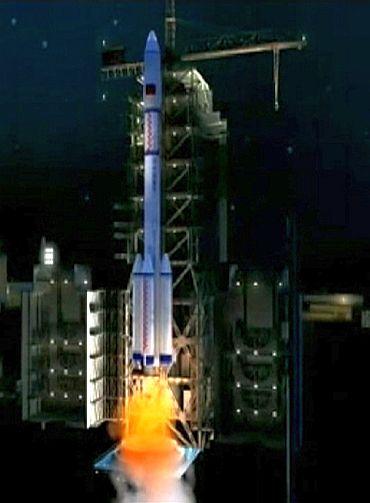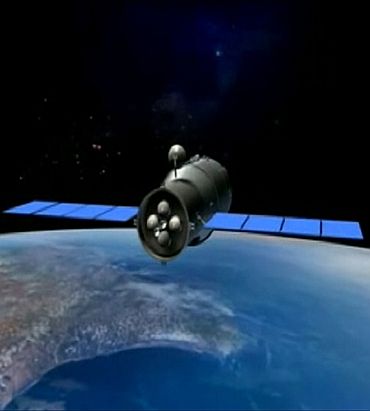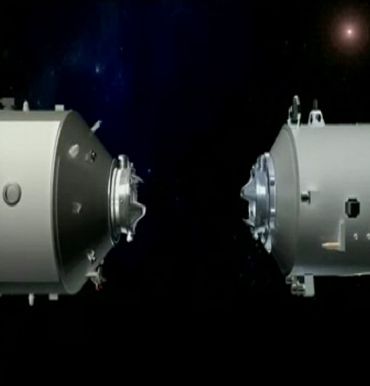Photographs: Jiuquan Satellite Launch Centre/Handout/Reuters
China is all geared up to launch into space on Thursday the first part of its maiden space lab Tiangong-1, which will form the test-bed for a larger 60-ton space station to be put in place by 2020.
Official media in Beijing reported that fuel has been injected into the Long March-2FT1 carrier rocket in preparation for launching the Tiangong-1 space module on Thursday evening.
There is considerable interest in Long March-2FT1 rocket that is the latest modified model of the Long March-2 rocket series and features a more powerful thrust force.
The Long March-2FT1, which has been given more than 170 improvements, is 52-metres long with a payload to low Earth orbit of 8.6 tonnes, Wu Ping, spokeswoman of the the Jiuquan Satellite Launch Centre in northwest China from where it will launched told media.
...
Tiangong-1, China's first step to a space lab
Image: A 3D animation of China's Tiangong-1 space module is shown in this still image taken from video released September 28Photographs: Jiuquan Satellite Launch Centre/Handout/Reuters
The modifications to the rocket were carried after Long March-2C rocket failed to send an experimental satellite into orbit on August 8, which was the first such setback after about 35 launches.
Engineers conducted comprehensive technical evaluations and made modifications to Tiangong-1's Long March-2F carrier rocket, which shares most of its components with the failed Long March-2C.
...
Tiangong-1, China's first step to a space lab
Image: A 3D animation of the working process of China's Tiangong-1 space module is shown in this still image taken from video released September 28Photographs: Jiuquan Satellite Launch Centre/Handout/Reuters
China has said that its space station, which is considerably smaller than the current 450-ton International Space Station will last for around a decade and support three astronauts working on microgravity science, space radiation biology and astronomy.
The Tiangong-1, Chinese name for Heavenly Palace will dock with China's Shenzhou-8, -9 and -10 spacecraft to be sent in the next few years.
Unmanned docking procedures will be essential for China's eventual goal of establishing a manned space station around 2020.
...
Tiangong-1, China's first step to a space lab
Image: A 3D animation of the interior of China's Tiangong-1 space module is shown in this still image taken from video released September 28Photographs: Jiuquan Satellite Launch Centre/Handout/Reuters
According to the China National Space Administration (CNSA), Tiangong-1 is an eight-ton-class space lab prototype with a cylinder-shaped body and two docking ports on its ends.
Both the Tiangong-1 and Shengzhou 8 are unmanned.
"The Shenzhou-9 and 10 will be piloted if the rendezvous result of the Shenzhou-8 and Tiangong-1 turn out well," an official recently told Xinhua news agency.
...
Tiangong-1, China's first step to a space lab
Image: A 3D animation of China's Tiangong-1 orbiting the Earth is shown in this still image taken from video released September 28Photographs: Jiuquan Satellite Launch Centre/Handout/Reuters
Space docking technology is key for building a space station and docking failures can have catastrophic consequences, he said.
China currently embarked on an ambitious space programme which included creating a new satellite system to rival GPS, a second moon mission to land a rover as a follow up to its successful lunar probe, Chang'e-II.
...
Tiangong-1, China's first step to a space lab
Image: Chinese soldier stands beside Long March II-F rocket loaded with China's unmanned space module Tiangong-1 at the launch pad in the Jiuquan Satellite Launch Center, Gansu province September 28Photographs: Petar Kujundzic/Reuters
Compared with carrier rockets that the United States and Russia have used to launch moon-landing vehicles and space station components, China's Long March rocket series is much less powerful, state-run Xinhua reported.
"China's manned space programme aims at building up a space station, so we need a more powerful carrier rocket," Jing told Xinhua at the launch centre.
"Research and development on a new, bigger carrier rocket that burns more environmentally-friendly liquid-oxygen-kerosene fuels is in progress," he said.
Click on MORE to see another feature...







article